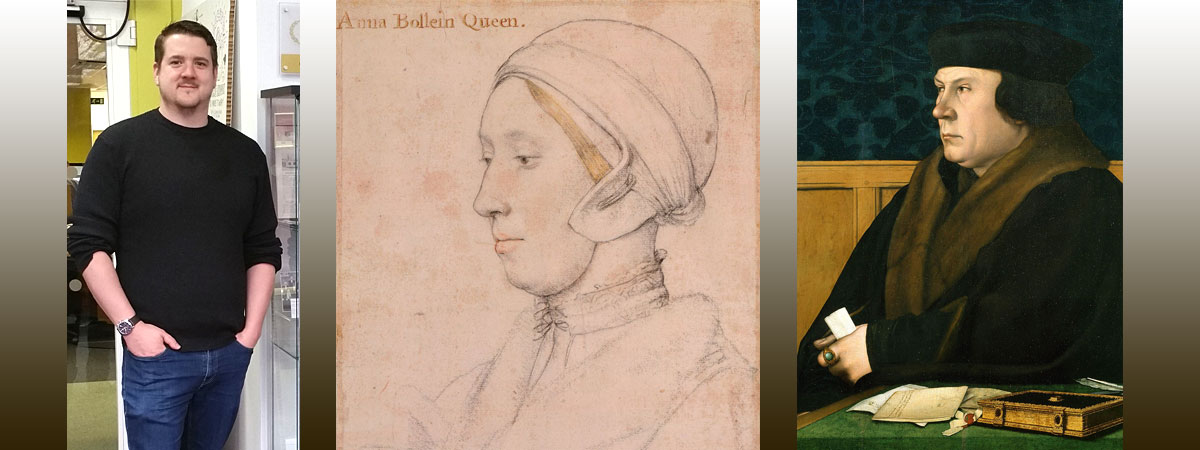 Researcher Andy Holroyde and court rivals Queen of England Anne Boleyn and chief minister Thomas Cromwell
Researcher Andy Holroyde and court rivals Queen of England Anne Boleyn and chief minister Thomas CromwellHistorian Andy Holroyde uncovers the prophecy that encouraged Thomas Cromwell to engineer Queen Anne’s downfall
ANNE Boleyn – second wife of Henry VIII – met her death on the scaffold in May 1536. Now, a historian at the University of Huddersfield has uncovered an obscure contemporary document that not only seemed to prophecy her downfall but might also have hastened it.
Andy Holroyde has written an article describing his findings. Headed Predicting the Fall of Anne Boleyn, it has been published by leading magazine History Today. The claim is that “prophecy was alive and well in Tudor England” and that Thomas Cromwell – King Henry’s chief minister – took a special interest in documents that purported to predict the future.
In 1535, he was sent a document printed in London but originating in Flanders, claiming to prophecy events for the following year. Andy Holroyde believes he might have uncovered it via a British Library archive known as The English Short Title Catalogue, consisting of more than 480,000 items published between 1473 and 1800.
After the downfall of Anne Boleyn, Cromwell confided that it was a prophecy made in Flanders “threatening the king with a conspiracy of those who were nearest his person”, which had roused his suspicions and made him enquire into the matter.
“This suggests that Anne was not simply the victim of a pre-planned attack, but rather that Cromwell undertook an investigation into Anne’s circle based on a prophetic warning of danger to the king,” writes Andy Holroyde.
He believes that the document he has unearthed might be the one containing a prophecy that would hasten the end of Anne. After finding a reference in The English Short Title Catalogue, he managed to track down and examine the original version in a Cambridge archive.
Divided into seven chapters, dealing with topics such as the coming harvest or outbreaks of disease, much of the prophecy is extremely general, writes Andy. But the section of most interest to Cromwell would have been the chapter concerning “the strife and trouble of this year, and the cause thereof”. It contains an unusually specific prediction of “secret treason”, suggesting a conspiracy behind closed doors.
Andy Holroyde’s article outlines the religious differences that had arisen between Thomas Cromwell and Anne Boleyn in the wake of the Reformation, with the Queen favouring the retention of traditional ceremony and also disagreeing over how proceeds from the dissolution of the monasteries should be spent.
Now, it is argued that the text unearthed by Andy Holroyde could have increased Cromwell’s determination to engineer Anne’s downfall.
“Anne’s fall was the result of an investigation that was undertaken to search out a conspiracy around the king to harm his person and that investigation was founded, as Cromwell said at the time, on a prophecy,” writes Andy Holroyde.
“In the frenzied atmosphere of those few days in May 1536, rumour became evidence, conversations became conspiracies and flirtations became treason, all under the cloud of a prophetic warning.”
Andy Holroyde’s History Today article was based on material from his MA dissertation on Prophecy and the Fall of Anne Boleyn, for which he was supervised by Professor Tim Thornton, a historian who is the University of Huddersfield’s Deputy Vice-Chancellor.
Now Andy – whose Twitter profile is @andyholroyde – has moved into modern British history and, as an AHRC Heritage Consortium Student, is completing a PhD thesis on “Remploy and Sheltered Employment in the British Welfare State, 1944-79”. His main supervisor is Dr Rob Ellis.
More Stories
Historian offers comment on Margaret of Anjou
Dr Katherine Lewis appeared BBC Radio 4 In Our Time programme about the life and reputation of Henry VI’s queen, Margaret of Anjou
Romanies/Gypsies culture and history exhibition
Dr Jodie Matthews is curating the exhibition of Romani/Gypsy people at the Brotherton Gallery, which runs to 31 July
Battlefield expert explores Wars of the Roses site
Dr Glenn Foard hopes to pinpoint the exact site of the battle known as Mortimer’s Cross
